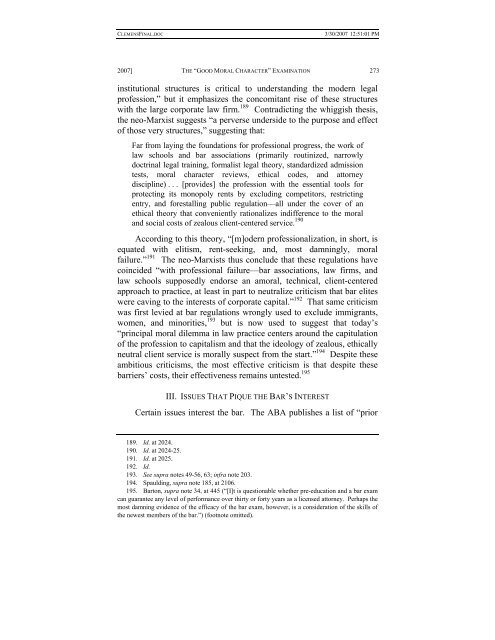Facing the Klieg Lights: Understanding the "Good Moral Character"
Facing the Klieg Lights: Understanding the "Good Moral Character"
Facing the Klieg Lights: Understanding the "Good Moral Character"
Create successful ePaper yourself
Turn your PDF publications into a flip-book with our unique Google optimized e-Paper software.
CLEMENSFINAL.DOC<br />
3/30/2007 12:51:01 PM<br />
2007] THE “GOOD MORAL CHARACTER” EXAMINATION 273<br />
institutional structures is critical to understanding <strong>the</strong> modern legal<br />
profession,” but it emphasizes <strong>the</strong> concomitant rise of <strong>the</strong>se structures<br />
with <strong>the</strong> large corporate law firm. 189 Contradicting <strong>the</strong> whiggish <strong>the</strong>sis,<br />
<strong>the</strong> neo-Marxist suggests “a perverse underside to <strong>the</strong> purpose and effect<br />
of those very structures,” suggesting that:<br />
Far from laying <strong>the</strong> foundations for professional progress, <strong>the</strong> work of<br />
law schools and bar associations (primarily routinized, narrowly<br />
doctrinal legal training, formalist legal <strong>the</strong>ory, standardized admission<br />
tests, moral character reviews, ethical codes, and attorney<br />
discipline) . . . [provides] <strong>the</strong> profession with <strong>the</strong> essential tools for<br />
protecting its monopoly rents by excluding competitors, restricting<br />
entry, and forestalling public regulation—all under <strong>the</strong> cover of an<br />
ethical <strong>the</strong>ory that conveniently rationalizes indifference to <strong>the</strong> moral<br />
and social costs of zealous client-centered service. 190<br />
According to this <strong>the</strong>ory, “[m]odern professionalization, in short, is<br />
equated with elitism, rent-seeking, and, most damningly, moral<br />
failure.” 191 The neo-Marxists thus conclude that <strong>the</strong>se regulations have<br />
coincided “with professional failure—bar associations, law firms, and<br />
law schools supposedly endorse an amoral, technical, client-centered<br />
approach to practice, at least in part to neutralize criticism that bar elites<br />
were caving to <strong>the</strong> interests of corporate capital.” 192 That same criticism<br />
was first levied at bar regulations wrongly used to exclude immigrants,<br />
women, and minorities, 193 but is now used to suggest that today’s<br />
“principal moral dilemma in law practice centers around <strong>the</strong> capitulation<br />
of <strong>the</strong> profession to capitalism and that <strong>the</strong> ideology of zealous, ethically<br />
neutral client service is morally suspect from <strong>the</strong> start.” 194 Despite <strong>the</strong>se<br />
ambitious criticisms, <strong>the</strong> most effective criticism is that despite <strong>the</strong>se<br />
barriers’ costs, <strong>the</strong>ir effectiveness remains untested. 195<br />
III. ISSUES THAT PIQUE THE BAR’S INTEREST<br />
Certain issues interest <strong>the</strong> bar. The ABA publishes a list of “prior<br />
189. Id. at 2024.<br />
190. Id. at 2024-25.<br />
191. Id. at 2025.<br />
192. Id.<br />
193. See supra notes 49-56, 63; infra note 203.<br />
194. Spaulding, supra note 185, at 2106.<br />
195. Barton, supra note 34, at 445 (“[I]t is questionable whe<strong>the</strong>r pre-education and a bar exam<br />
can guarantee any level of performance over thirty or forty years as a licensed attorney. Perhaps <strong>the</strong><br />
most damning evidence of <strong>the</strong> efficacy of <strong>the</strong> bar exam, however, is a consideration of <strong>the</strong> skills of<br />
<strong>the</strong> newest members of <strong>the</strong> bar.”) (footnote omitted).
















